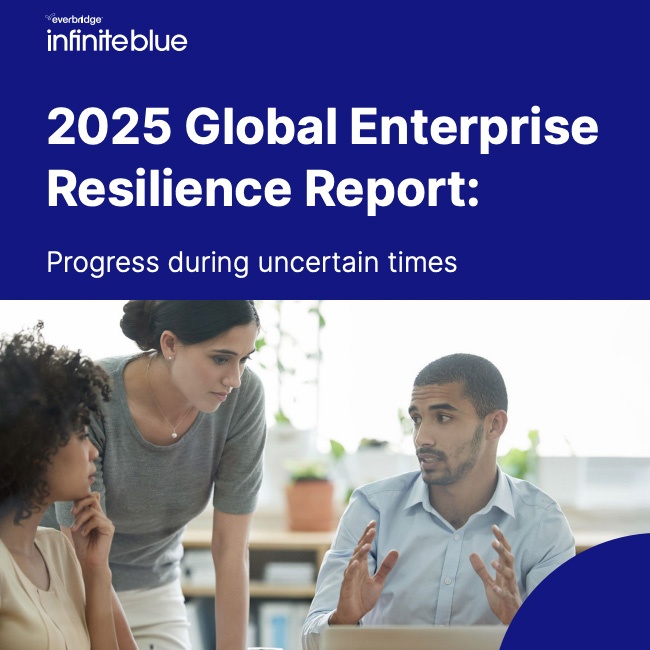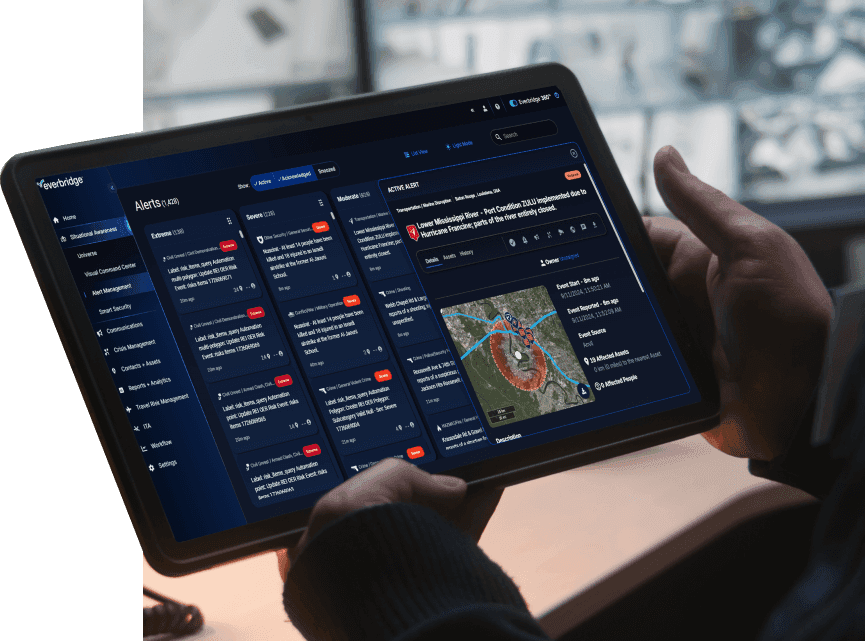Ensure business continuity
Future-proof your organization’s resilience by automating and streamlining business continuity and disaster recovery programs. Our High Velocity Critical Event Management platform, Everbridge 360™, integrated with our resilience planning platform BC in the Cloud®, provides clarity and control over any disruption, ensuring that your organization remains robust and prepared.

Protect critical business operations
In today’s complex and fast-moving risk environment, a business continuity plan alone doesn’t guarantee resilience. Organizations need the ability to act quickly, communicate clearly, and coordinate effectively across teams and systems when critical events arise. BC in the Cloud, together with Everbridge 360, delivers a unified solution that bridges planning with response—ensuring organizations are ready when disruption strikes.
Through seamless integration with Everbridge 360, BC in the Cloud empowers organizations to align business continuity processes with real-time incident management, emergency communications, and operational response. The result: continuity strategies that move from static plans to dynamic, coordinated actions—ensuring people, operations, and systems stay protected when every second counts.
Together, Everbridge and BC in the Cloud use our Purpose-built AI functionality to help ensure business operations, people relations, security, and digital operations run smoothly when every second counts.
Technological integration
Ensuring seamless incorporation of technology can often lead to gaps or vulnerabilities.
Resource allocation
Balancing limited resources while addressing a crisis can hinder effective response strategies.

Crisis communication
Misinformation and delayed responses can impact stakeholder confidence.
The combined expertise of Everbridge 360 and BC in the Cloud
Enhance and automate your business continuity and disaster recovery solutions to maintain clarity and control during disruptions. By leveraging the combined capabilities of Everbridge 360 and BC in the Cloud, you can anticipate risks, predict impacts, enhance collaboration, and improve communication, enabling your organization to emerge stronger than ever.

Prepare to respond to business continuity with Everbridge solutions
Benefits
- Enhanced resilience: a comprehensive approach to business continuity to minimize disruptions and safeguard operations.
- Improved communication: rapid and efficient communication enhancing decision-making processes.
- Operational efficiency: automated processes and integrated risk intelligence allow organizations to efficiently manage resources and maintain business functions.
- Seamless technology integration: the Everbridge platform seamlessly integrates with existing systems, without the need for extensive reconfiguration or downtime.
- Scalability and flexibility: designed to grow with your organization, Everbridge offers scalable solutions that can adapt to changing needs.
- Enhanced compliance: by ensuring adherence to industry standards and regulations, Everbridge helps organizations meet compliance requirements.

Features
- Mass Notification: sends targeted alerts to individuals and groups based on location and situation, ensuring timely communication.
- Risk intelligence integration: monitors and analyzes risks in real time, providing actionable insights to mitigate potential disruptions.
- Location awareness: offers real-time threat monitoring and automated alerts, based on employee location, to keep them informed about potential dangers.
- Visual command center: provides a unified view for managing enterprise risks and efficient handling of critical events.
- Control center: unifies safety and security systems, delivering actionable alerts and automated reports to effectively manage and mitigate internal and external threats.
- CEM for Digital Operations: protects digital infrastructure by integrating data feeds and providing intelligence to identify and counteract evolving digital threats.
Solution
The business continuity solutions from Everbridge empowers organizations to effectively manage critical events by enhancing risk identification, communication, and operational resilience. With advanced risk intelligence and automation, it enables proactive threat monitoring and impact analysis. The platform ensures rapid, clear communication with stakeholders during disruptions, safeguarding employees and assets. By integrating real-time alerting and resilience tools, Everbridge ensures seamless operation continuity, keeping businesses prepared and protected at all times.


BC in the Cloud helps WEX, Inc. achieve operational resilience
With limited capabilities from its existing business continuity and disaster recovery software, WEX began researching alternative solutions in 2017. The rapidly growing company needed a system that was flexible, scalable, provided greater reporting capabilities, and offered a positive end-user experience.
WEX narrowed its initial research of dozens of vendors down to five companies, then to three, and ultimately selected BC in the Cloud.
How it works
Everbridge business continuity solutions operate by leveraging advanced risk intelligence and real-time alerting to manage critical events effectively. It integrates monitoring and impact analysis tools to proactively identify and assess threats. Through its robust communication platform, it ensures rapid dissemination of crucial information to stakeholders, safeguarding operations and personnel. This seamless integration of features enables organizations to maintain safety and operational continuity in the face of disruptions.


2025 Global Enterprise Resilience Report
Disruptions are inevitable and unpredictable, and organizations must have a flexible, dynamic approach that enables them to achieve true enterprise resilience.
Outcome
Utilizing the latest business continuity software from Everbridge offers organizations enhanced safety and unwavering operational continuity. Together, our High Velocity Critical Event Management solutions empower organizations to manage crises with precision. The solutions offer robust risk intelligence and communication capabilities to ensure swift, informed responses to threats to minimize disruptions. These outcomes bolster organizational resilience and preparedness, fostering a proactive approach to risk management that safeguards employees and assets while maintaining trust and stability in challenging times.

Featured case studies

Multinational financial service saves time and cost with critical event management
Within a single platform, Santander can now coordinate all response activities, teams, and resources to accelerate recovery times and maintain command and control during a crisis.

HealthEquity demonstrates operational resilience
HealthEquity utilizes Everbridge before, during and after severe weather storms to communicate with team members to ensure the safety of their people, handle operations and to communicate decisions.

A global fintech company used BC in the Cloud® to increase efficiency, accuracy, and executive confidence in its resilience program
A global financial services technology company used our solutions to improve its business continuity and disaster recovery (BC/DR) program that was managed through disparate systems and required manual reconciliation.

Improving business continuity for financial services: CIBC Mellon case study
CIBC Mellon selected the Everbridge Unified Critical Communication Platform to support its business continuity initiatives and improve critical communication planning, threat monitoring and response.

How a large, complex university used BC in the Cloud® to reach higher levels of readiness
Preparing for business disruptions requires coordination and visibility between all relevant teams, processes, and stakeholders. As organizations become larger and more
complex, this becomes even more important.

BC in the Cloud® helps Houston Methodist Hospital triage power outage
Houston Methodist Hospital is ranked by US News & World Report as the best hospital in Texas and 15th in the nation. It provides health care from eight hospitals and 100 clinics, all networked from a central location on the Texas Medical Center campus. A hospital must be prepared to offer state-of-the-art, split-second care at any moment.

APL Logistics enhances global risk management with Everbridge solutions
APL Logistics, a global leader in supply chain solutions, partnered with Everbridge to enhance risk management and business continuity.
Industry solutions for business continuity
IT industry
For the IT industry, business continuity enhances organizational resilience by enabling firms to proactively plan and assess risks. It involves monitoring system vulnerabilities and implementing robust solutions. These strategies protect sensitive data, ensure uninterrupted operations, and maintain system integrity, empowering IT organizations to effectively manage cyber threats and safeguard critical digital infrastructure.

Financial institutions
For financial institutions, business continuity ensures the stability of financial operations by proactively planning and assessing potential risks. It involves safeguarding assets and maintaining compliance through continuous monitoring and implementation of strategic solutions. These measures bolster customer trust, protect financial data, and enable institutions to effectively navigate unforeseen disruptions while preserving financial integrity and operational resilience.

Telcomms
For the telecom industry, business continuity enhances network resilience by enabling companies to proactively plan, assess risks, and monitor network vulnerabilities. This involves implementing strategic solutions to ensure consistent service delivery and customer communication. These efforts protect critical infrastructure, maintain operational flow, and empower telecom providers to effectively manage disruptions and uphold service reliability amidst unexpected challenges.

Government
For governments, business continuity enhances resilience by enabling proactive planning, risk assessment, and continuous monitoring of critical functions. By implementing strategic solutions, governments ensure the uninterrupted delivery of essential services and maintain public trust. These measures bolster operational integrity, allowing governments to effectively manage unexpected disruptions and protect vital public infrastructure, ensuring societal stability and security.

Corporate impact
For corporates, business continuity enhances operational resilience by enabling companies to proactively plan, assess risks, and continually monitor potential vulnerabilities. By implementing strategic solutions, businesses ensure the protection of vital assets and the stability of operations. These measures maintain stakeholder confidence and allow corporates to effectively navigate disruptions, safeguarding their competitive edge and ensuring long-term sustainability.

Healthcare
For healthcare organizations, business continuity enhances care resilience by enabling providers to proactively plan, assess risks, and monitor operational vulnerabilities. Through strategic solutions, healthcare facilities ensure uninterrupted patient care and continuous medical services. These practices protect critical healthcare infrastructure, maintain service integrity, and empower organizations to effectively manage disruptions, ensuring patient safety and service reliability amidst unforeseen challenges.

Related resources

Resilient and ready on all fronts
At a time of rising geopolitical tensions, increasingly frequent and destructive natural disasters, and cyber and retail crime epidemics, organizations must be prepared to respond.

The business case for BC/DR (business continuity & disaster recovery)
BC/DR ensures the company has the ability to quickly and effectively react to a negative change from a disruptive event (natural or manmade) by having and implementing proactive and reactive strategies to safeguard its stakeholders and revenue.

Developing a Disaster Recovery Plan: A Comprehensive Guide
It may seem like a disaster recovery plan and a business continuity plan are the same thing, but businesses must understand the difference between disaster recovery vs. business continuity planning.

How to create a business continuity plan
Maintaining stable business operations is key. Given the growing number of risks companies face today, businesses will continue to face ever-changing disruptions, and quickly acting on them requires having a solid business continuity plan (BCP) in place.

Achieving enterprise resilience – The standard for preparedness is about to be raised again
In today’s high-risk environment, businesses must not only be able to respond effectively to disruptions, but they must also be able to return to operations faster and more confident than before.

Business continuity FAQs
Business continuity refers to the strategic and tactical capability of an organization to plan for and respond to incidents and business disruptions in order to continue operations at an acceptable predefined level.
Business continuity is crucial because it ensures that essential functions can continue during and after a disaster, minimizing operational disruptions and financial losses while safeguarding the organization’s reputation.
To implement a business continuity plan, identify critical business functions, assess potential risks, develop strategies to maintain operations during disruptions, and communicate the plan to all stakeholders.
Key components include risk assessment, business impact analysis, recovery strategies, plan development, and testing and maintenance procedures.
A business continuity plan should be tested regularly, at least annually, to ensure effectiveness and make necessary updates based on new risks or changes in business operations.
